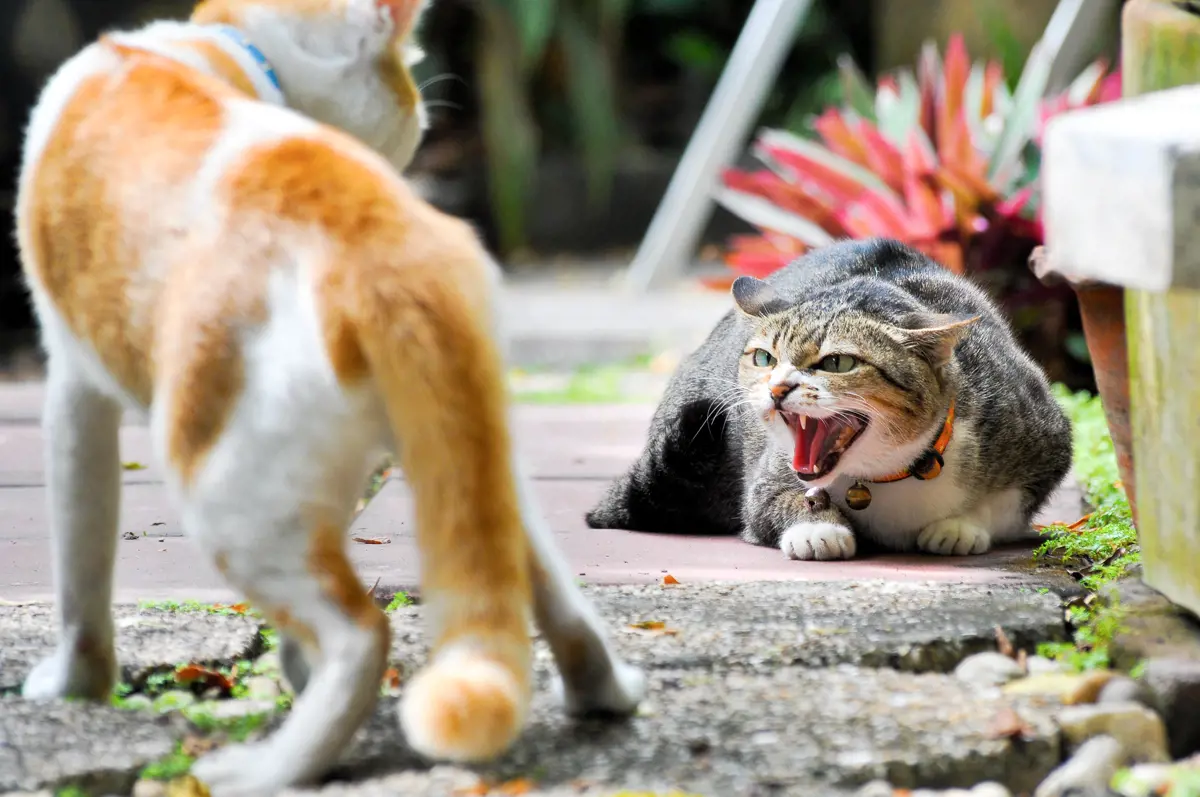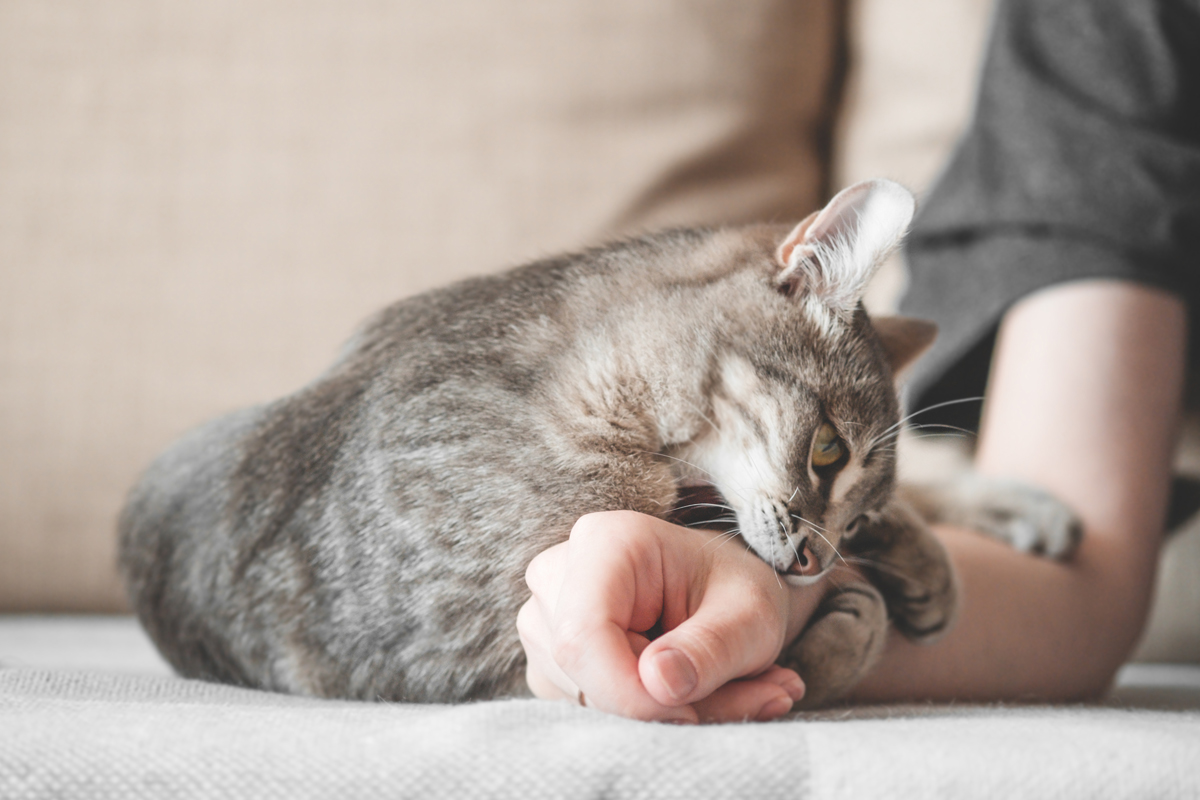Why do cats fight?
2nd March, 2021

If you’re a cat lover, you’ll know just how gentle and affectionate these cute creatures can be – most of the time! But like any animal, cats can get angry or aggressive, especially when they feel their territory might be under threat.
If you’ve ever seen or heard a cat fight, you’ll know just how upsetting it can be.
All that hissing and wailing is enough to make anyone run a mile! But what exactly makes cats start fighting in the first place? What should you do if you see cats fighting? And what happens if they turn their aggression on you?
Cat fights are simply a part of life with our furry friends and something that all cat parents will experience at some point during their ownership.
While you can’t stop every fight, you can make sure your puss gets the best possible treatment if it suffers any injuries through your cat insurance.
At Purely Pets, we can offer cover that will protect your favourite feline throughout its entire life, with cover for vets’ fees up to £15,000.
So let’s find out a little more about why cats fight and what you can do, as a responsible pet owner, to curb that aggressive behaviour.
Why do cats fight?
Protecting their territory
Unlike our doggy companions, cats are solitary animals. They don’t naturally live in packs so when another cat comes wandering into its territory, it’s automatically on high alert.
Cats mark out their territory by scent marking, which is usually a pretty good indicator to other cats to stay away. But when more adventurous felines wander in, there might be a standoff!
Who is this intruder and why are they on my patch? Cats will mark the areas in which they feel safe, which usually includes your home and garden but can extend further, especially for unneutered pets that tend to roam further afield.
Same-sex aggression
Same-sex cats that are still ‘intact’ are most likely to get into fights, especially around mating season.
Spaying or neutering before their first birthday is one of the best ways to stop aggressive tendencies from developing when they’re older.
It also helps to prevent other health issues such as urine infections, cancer and prostate problems.
Read our blog on does pet insurance cover spaying for more information about this procedure.
Change of pecking order
This is definitely something to consider if you’re thinking about introducing another cat to your household. When a new kitty comes into, or leaves, the cat’s social group, they may fight to re-establish a new pecking order.
You may see older cats getting frustrated with younger kittens too, which may lead to aggression or fights as they reaffirm who’s in charge.
A new routine
Cats are creatures of habit and any big changes in their routine could have a negative effect on their behaviour. Something as seemingly insignificant as moving their food bowls or rearranging litter boxes could cause fights.
Pain
If your cat is usually docile but has suddenly become very aggressive towards you, it could be that they are in pain.
Perhaps they’re suffering from an underlying health condition that is causing discomfort and their aggression is their way of telling you not to touch! Take them to the vets for a check-up just to make sure everything’s OK.
Maternal aggression
If your cat has just given birth she will be very protective of her new kittens, just like any new mum. She may hiss, chase or try to bite other cats that come close, but this should subside after the kittens have been weaned.
What are the signs that a cat has been in a fight?
Some owners may be worried that they won’t notice their cat has been in a fight. You should be inspecting your cat regularly anyway, just to check their overall health, but specific signs that they might have been involved in an altercation include:
-
Bleeding or dried blood on their fur
-
Limping or unstable on their feet
-
Lethargy
-
Lumps, bumps, swelling or pus
-
Puncture wounds (usually found in pairs)
-
Flinching when touched
Any obvious injuries should be treated immediately.
If you’re not sure if you need to go to the vet, call the Purely Pets 24 Hour Vet Helpline, where you can get advice on the best course of action.
Infections caused through fighting can become serious if they’re not treated promptly, sometimes affecting bones and joints as well, so don’t take a chance.
Seek professional advice as soon as possible.
Should you try to stop cats fighting?
As the PDSA explains, there are several things you can do to prevent your puss getting into a fight in the first place.
They suggest letting them go outside when they want to. Let them dictate the time by having a cat flap that they can use as and when they please.
This will help them to avoid bumping into other problem cats in the neighbourhood and roam around without fear. Think about investing in a cat flap that only recognizes your own cat’s microchip.
That way, strange cats won’t be able to get into your house while you’re not around.
They also remind owners that gardens should be secure – ideally with a high fence that has a 45-degree angle on top to stop other cats from entering your garden so easily.
If the worst happens and you actually see your cat in a fight, don’t panic.
The first thing to do is to move children or any other animals away from the situation.
Don’t be tempted to intervene – you’ll only end up getting scratched or injured yourself.
While you should never attempt to hit the animals in any way, you could try squirting them with water.
Cats will usually run away from the spray of a hose or watering can, which may help break up the fight.
Another way to stop a cat fight is through distraction. A loud bang, shout or clapping of hands should do the trick in the majority of cases.
Don’t try to console or cuddle your cat immediately after the fight as they may still be defensive and could hurt you by mistake.
If you have to move the cat for their own safety – perhaps they’re injured and lying in a road – carry them in a thick blanket and call the vet immediately.
How to tell the difference between fighting and playing
It’s wonderful to see two cats playing and tumbling around with each other but what happens when that play gets a little too rough? Sometimes it can be hard to spot exactly when the normal play stops and the fighting starts, especially if you’re a new cat owner.
Look out for these four telltale signs that playtime is about to get nasty:
Hissing or screaming
Cats who are playing normally will usually be silent or quiet.
A puffed-up tail
Also known as piloerection, a puffed-up tail can be a sign of a fearful or angry puss.
Claws on show
Scratching is not usually part of a normal playtime routine so if the claws are out, it means things are getting serious.
Ears pinned back
A cat’s ears are usually soft and forward facing, unless they’re angry or in fear, in which case they will be pinned back against the head.
Other signs of an aggressive or angry cat can include:
-
Curved tail, tucked inwards
-
Crouching low
-
Turning sideways to their opponent
-
Spitting and opening their mouth
-
Dilated pupils
How to stop cats fighting in the house
If you’re a multi-cat household, it’s likely that you’ll experience a cat fight at some point in your ownership. While the odd confrontation is normal, regular fighting between your feline friends means you need to alter their behaviour, for the cats’ wellbeing as well as your own.
Spruce Pets suggests that you should increase your cat’s territory so they have more room to play. Are they confined to one or two rooms? Why not give them a third to explore?
Having to constantly fight for space, litter trays, toys and so on is bound to put them in a foul mood after a while!
If things are really bad, they also suggest you should try reintroducing your cats as if it was the first time they’d met. Keep the two felines apart in different rooms for a week or so.
That means separate beds, toys, litter trays, food, everything! They’ll still be able to smell each other but physical fights will be impossible.
After a week, switch the cats over, so they can experience a new environment and pick up on each other’s scents even more.
Then, after a few more days, open the door between the rooms a few inches so they can see each other. If they stay relaxed, open the door wider and wider until they’re in the same room.
If you spot any signs of aggression through this process, go back a stage and start again.
It may take some time to get the cats reacquainted but it will be worth it for a fight-free household and it could save you from having to claim on your cat insurance.
Living with cats should be an enjoyable experience rather than feeling like you’re a referee!
What happens if your cat becomes aggressive with you?
It’s one thing for your cats to get annoyed with each other but what about when they start taking their aggression out on you?
Living with a kitty who scratches, bites or constantly attacks you, your children or your visitors will quickly become tiresome. If it doesn’t get better with time, you may even consider giving your cat up for adoption.
But there are many things you can do before it reaches that point.
After all, coping with behavioural problems is all part and parcel of being a pet parent and you need to do all you can to get to the reason behind the aggression.
Write down what caused the incident if you can. This may help you and the vet identify a trigger for this negative behaviour.
Never hit or punish the cat – this will only lead to more aggression.
Try not to approach them and keep eye contact to a minimum. You should keep feeding them and changing their litter tray as normal though.
If your cat is constantly pouncing on you, try to keep your arms and legs covered with thick jumpers and jeans. You may need to wear shoes too if they’ve taken to attacking your feet.
Try to act as normal as possible, otherwise your cat may interpret your anxiety as a threat. This type of attacking behaviour isn’t normal and you need to seek the help of a cat behaviourist or veterinary professional as soon as possible.
What should you do if a cat bites you?
Cat bites that break the skin can be extremely painful and the small puncture holes can close over quickly trapping any infection inside.
That’s why it’s important to wash the bite marks with clean, warm water and seek the advice of a doctor as soon as possible.
They may advise further treatment, such as a tetanus jab.
Protect your puss with cat insurance
We can’t control our cats every minute of the day. Who knows where they wander when they leave the house? But if your puss is protected with cat insurance you know that you’ll be financially covered if they get into any scrapes!
Cat insurance from Purely Pets puts you in control. With 15 levels of cover to choose from, you can pick the policy that’s right for you and manage it online at a time that suits.
Got a question about your cat? Our 24-Hour Vet Helpline is on hand to give you the professional advice you need.
Take a look at some of our TrustPilot reviews to see what other cat owners say about the service.
Helpful Pages
Recent Posts
Pet Insurance Quote
- 98% claims paid *
- Claims paid directly to vets
- 24/7 vet video consultations
- Interest free monthly payments





